
Tips and advice motorbike
Do you feel an abnormal vibration in the handlebars when you ride? Perhaps one of your wheels needs balancing. Read on to learn more about motorcycle wheel balancing.
Contents of the article:
What is a motorcycle wheel balancing?
A wheel and a tyre are never perfectly circular. Therefore, if a wheel is rotated on an axis, the rotational movement is not homogeneous due to the irregular distribution of masses. This rotation causes "jumps". On a motorcycle, these jumps rise up through the fork and cause abnormal and unpleasant vibrations at the handlebars.
Motorcycle wheel balancing consists of placing weights at specific points on the wheel to compensate for the imbalance in order to obtain a smooth rotational movement.
What causes a wheel to become unbalanced?
Because of its main material (rubber), a tyre cannot be perfectly round. This is why every tyre fitted to a wheel must be balanced, even when the tyre is new.
In use, other events may cause an imbalance. For example, hitting a kerb can deform the wheel and therefore create an imbalance. It can also happen that one or more weights are lost while riding if they have not been properly glued. In such cases, you may notice an abnormal vibration while driving.
When should a wheel be balanced?
If you notice an abnormal vibration while riding, we advise you, of course, to visit your dealer or a professional.
Abnormal vibrations should always be treated because, in addition to making riding unpleasant, they can cause premature wear to parts of your motorbike. Wheel and steering column bearings, for example, as well as fork tubes suffer from abnormal fatigue due to these vibrations.
The professional will examine your wheels to determine if any of them are out of balance, and if so, will perform a motorcycle wheel balancing procedure. If abnormal vibrations persist despite a satisfactory balance of the wheels, he will then investigate other possible causes to eliminate them.
Motorcycle wheel balancing: the off-road exception
For off-road riding, motorcycle wheel balancing is not required. For this activity, motorbikes are often fitted with foam tyres and "gripsters" which are added to the wheel to prevent the foam from turning. These add-ons actually cause unbalance, which is considered unnecessary to correct. Why is this? Simply because shocks, bumps and vibrations are intrinsic to off-road riding.
How is a wheel balanced?
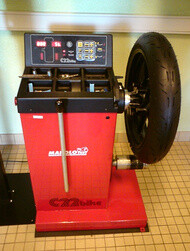
The professional usually uses a balancing machine, i.e. a semi-automatic machine that rotates the tyre and identifies the location of any imbalance.
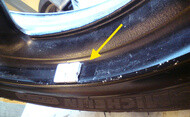
In this picture, two white masses have been placed side by side on the wheel. It can be seen that a third mass, which was previously present, has been removed.
He places the tyre-wheel assembly on the machine's axle, manually enters data such as the wheel diameter and width. After rotating the wheel, the balancing machine indicates the point of unbalance and what mass it represents.
The professional can then stick a mass on the wheel, opposite the unbalance, to compensate it. To total the required mass, he places one or more bars on the wheel at the indicated point.
When you buy a motorbike, it is delivered with tyres and wheels that have already been balanced. If the professional needs to replace your tyre, he will balance it after it is fitted with new masses.
Static and dynamic wheel balancing
There are two possible ways to balance a wheel.
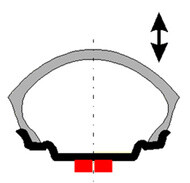
Static balancing
Static balancing consists of placing the weights in the centre of the wheel, on the flat of the rim (see diagram below). This method, which can be done with or without a machine, only balances the vertical axis of the wheel.
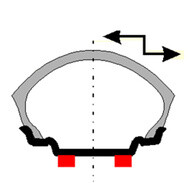
Dynamic balancing
Dynamic balancing consists of placing weights opposite the identified unbalances when they are not in the centre of the tyre-wheel assembly, but rather on the edges. This method, more complex but also more efficient, is carried out with a balancing machine that allows the wheel to be balanced horizontally as well as vertically.
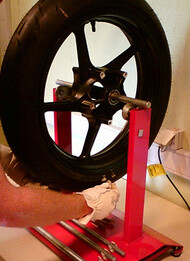
Dynamic, semi-automatic wheel balancing
In some cases, dynamic balancing is performed without a balancing machine. For example, during track competitions or for certain scooter tyres whose smaller diameter is incompatible with the machine.
The professional then uses an accessory with an axle that allows the wheel to be rotated manually and manages to determine, thanks to his skills, where the unbalance is and what mass is needed in order to compensate it.
In competition, the balancing is done as accurately as possible.
It is on the road, however, and especially on the straights, that one can feel discomfort with a continuous vibration in the handlebars if the wheel is not correctly balanced.
Can I balance a wheel myself?
As you can understand, balancing requires specific equipment and skills. This is why we recommend that you consult a professional as soon as you notice an abnormal vibration so that he can investigate the cause and, if necessary, balance the wheels.
You can use our tool below to find a professional near you.

Find a tyre dealer near you in seconds
Search by
Address, City or Postcode
Motorbike
Locate me
Top 5 cities in the UK

